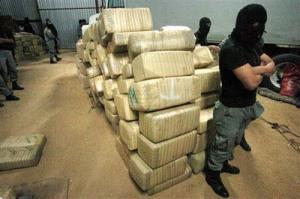by Bernd Debusmann, Jr.
Mexican drug trafficking organizations make billions each year smuggling drugs into the United States, profiting enormously from the prohibitionist drug policies of the US government. Since Mexican president Felipe Calderon took office in December 2006 and called the armed forces into the fight against the so-called cartels, prohibition-related violence has killed more than 38,000 people, including more than 15,000 last year. The increasing militarization of the drug war and the arrest or killing of dozens of high-profile drug traffickers have failed to stem the flow of drugs -- or the violence -- whatsoever. The Merida initiative, which provides $1.4 billion over three years for the US to assist the Mexican government with training, equipment and intelligence, has so far failed to make a difference. Here are a few of the latest developments in Mexico's drug war:

In Morelia, Michoacan, authorities discovered 21 bodies near the five main highway exits into the city. The men, all thought to be between 20 and 35 years old, were left alongside notes which identified them as petty criminals and warning others. Some of the bodies were reported to show signs of torture. Morelia is the hometown of President Calderon.
In Hidalgo County, Texas, at least three suspected drug smugglers were wounded after a fire fight with US law enforcement officers along the Rio Grand. The officers were apparently trying to intercept a large drug shipment when they came under fire from the Mexican side of the border.
In Ciudad Juarez,a peace march led by Mexican writer and poet Javier Sicilia arrived in the city with about 1,500 followers. The march left from Cuernavaca on June 5. In late March, Javier Sicilia's son was killed near Cuernavaca alongside several friends.
Also in Ciudad Juarez, nine people were murdered in several incidents across the city, making it the most violent day in the city so far in June. In one incident, two men were killed after their vehicle was attacked by gunmen armed with assault rifles.
Saturday, June 11
In the small town of El Terrero, Chihuahua, five members of a family were gunned down by a group of gunmen. Witnesses later reported that the men came searching for another target, and that the family was killed when they said they didn't know where he was. Two of the dead were children aged 3 and 4.
Sunday, June 12
In the municipality of General Teran, Nuevo Leon, three mutilated and dismembered bodies were found at the main entrance to the town. The dead are presumed to be members of the Gulf Cartel, as two banners signed by the Zetas were left at the scene threatening Gulf Cartel leaders M3 (Samuel Flores-Borrego) and R1 (Juan Reyes Mejia Gonzalez). In January, two police officers in General Teran were kidnapped and killed in a similar fashion, which lead to the town's entire police force quitting.
Monday, June 13
In the city of Chihuahua, a police commander was shot and killed after leaving a hospital, where he had been treated after being wounded in another attempt on his life earlier that day.
In Monterrey, a man was hung from a bridge and set on fire. Hundreds of motorists and pedestrians were in the area to witness gunmen arriving at the bridge, douse the victim in flammable liquid and throw him over the side of the overpass. The same bridge was the scene of a similar crime the previous Wednesday, in which gunmen hung two men.
Tuesday, June 14
In Tijuana, former Mayor Jorge Hank Rhon was cleared of federal weapons charges, but was immediately taken into state custody without charges as investigators seek to collect evidence for a murder trial. According to Baja California authorities, at least two weapons of the many that were recovered from his house have been used in homicides.
In the United States, an unnamed State Department official confirmed that at least one American citizen was among the 193 bodies recovered from mass graves in the San Fernando, Tamaulipas area in April.
[Editor's Note: We cannot accurately tally the drug prohibition-related killings in Mexico at this time. El Universal, the only Mexican newspaper that was doing so on a regular basis, has stopped. We will have to rely on official pronouncements on the death toll, and will report them when they happen. Below are the numbers through the end of last year. With more than 1,400 reported dead in April alone, this year's toll could well exceed last year's. As of this month, we believe the total death toll has surpassed 38,000.]
Total Body Count for 2010: 15,273
Total Body Count for 2009: (approx.) 9,600
Total Body Count for 2008 (approx.): 5,400
Total Body Count for 2007 (approx): 4,300
Total Body Count for Calderon's drug war through 2010: 34,883
Comments
Why doesen't the American people understand?
Add new comment